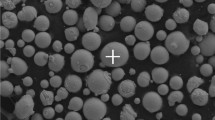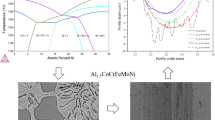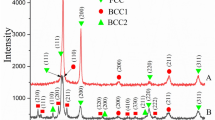Abstract
The structural condition and wear resistance of electrochemical Co-B and Ni-B coatings with different amounts of boron, as well as Ni-Co-Fe-Cr-Mo-Si-B and Ni-Fe-Si-B amorphous alloys obtained by rapid solidification from the melt have been studied. It has been found that in Co-B and Ni-B coatings with a boron concentration less than 8 at %, there is formed a solid solution of boron in the matrix phase, and the coatings are characterized by a high fracture strength upon friction. At a boron concentration from 8 to 15 at %, there is formed in the coatings a metastable amorphous structure with a decreased wear resistance. An increase in the B concentration to 20 at % stabilizes the amorphous structure of coatings, which leads to an increase in their fracture strength. A conclusion is made that during friction interaction at the surface of amorphous layers there are formed crystalline layers, which are subject to tensile stresses and are characterized by a decreased fracture strength. The difference in the wear resistance of the alloys studied is explained by a different deformation and thermal stability of the amorphous structure of the material.
Similar content being viewed by others
References
A. M. Glezer and B. V. Molotilov, Structure and Mechanical Properties of Amorphous Alloys (Nauka, Moscow, 1992) [in Russian].
I. V. Zolotukhin, Physical Properties of Amorphous Metallic Materials (Metallurgiya, Moscow, 1986) [in Russian].
K. Suzuki, H. Fujimori, and K. Hashimoto, Amorphous Metals (Butterworths, London, 1982; Metallurgiya, Moscow, 1987).
G. E. Abrosimova, A. S. Aronin, S. V. Dobatkin, et al., “Nanocrystallization of an Amorphous Fe80B20 Alloy during Severe Plastic Deformation,” Fiz. Tverd. Tela 49(6), 983–989 (2007) [Phys. Solid States 49 (6), 1034–1039 (2007)].
V. D. Zozulya, E. L. Shvedkov, D. Ya. Rovinskii, et al., Dictionary-Handbook on Friction, Wear and Lubrication of Machine Parts (Naukova Dumka, Kiev, 1990) [in Russian].
V. V. Sviridov, T. N. Vorob’eva, T. V. Gaevskaya, et al., Precipitation of Metals from Aqueous Solutions (Universitetskoe, Minsk, 1987) [in Russian].
L. S. Tsybul’skaya, V. A. Kukareko, Yu. N. Bekish, et al., “Chemical Composition, Structure and Properties of the Electrochemical Coatings Cobalt-Boron,” Zh. Prikl. Khim. 81(9), 1479–1483 (2008) [Russ. J. Appl. Chem. 81 (9), 1554–1558 (2008)].
Ya. I. Val’syunene and P. K. Norkus, “Determination of Boron in Nickel and Cobalt Coatings,” Tr. Akad. Nauk Litov. SSR, Ser. B., No. 1, 93–96 (1972).
M. A. Krivoglaz, X-ray and Neutron Diffraction in Real Crystals (Naukova Dumka, Kiev, 1983) [in Russian].
A. F. Skryshevskii, Structural Analysis of Liquids and Amorphous Solids (Vysshaya Shkola, Moscow, 1980) [in Russian].
C. H. Bennet, D. E. Polk, and D. Turnbull, “Role of Composition in Metallic Glass Formation,” Acta Metall. 19(12), 1295–1298 (1971).
J. L. Finney, “The Structure of Laboratory and Computer-Built Random Packing,” J. Phys. Colloq. 36 (1975).
H. S. Chen and K. A. Jackson, “Influence of Alloy Composition on Glass Formation and Properties,” in Metallic Glasses, Ed. by H. J. Leamy and J. J. Gilman (American Society for Metals, Metals Park, Ohio, 1978; Metallurgiya, Moscow, 1984), pp. 74–96.
M. Trudeau, R. Shulz, D. Dussault, and A. van Neste, “Structural Changes during High-Energy Ball Milling of Iron Based Amorphous Alloys: Is High-Energy Ball Milling Equivalent to a Thermal Process?” Phys. Rev. Lett. 64, 99–102 (1990).
P. A. Vityaz’, G. G. Goranskii, V. I. Zhornik, et al., “Evolution of Nickel-Iron-Based Amorphous Alloy Structure under Friction,” Trenie Iznos 29(4), 362–368 (2008) [J. Friction Wear 29 (4), 271–276 (2008)].
Author information
Authors and Affiliations
Additional information
Original Russian Text © V.A. Kukareko, 2011, published in Fizika Metallov i Metallovedenie, 2011, Vol. 111, No. 3, pp. 304–314.
Rights and permissions
About this article
Cite this article
Kukareko, V.A. Structural state and fracture strength upon friction of boron-containing alloys and coatings with an amorphous structure. Phys. Metals Metallogr. 111, 294–303 (2011). https://doi.org/10.1134/S0031918X11020104
Received:
Accepted:
Published:
Issue Date:
DOI: https://doi.org/10.1134/S0031918X11020104




